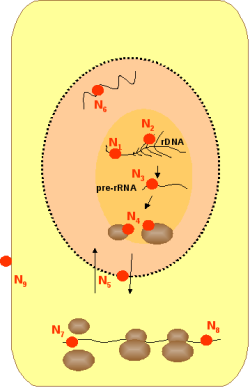Accueil du site > Thèmes de recherche > Assembly of chromatin and ribosome biogenesis. Project leader : Philippe Bouvet. > Projets de Recherches > Function of an histone chaperone, Nucleolin, in nucleolar function
Function of an histone chaperone, Nucleolin, in nucleolar function
Profound alterations of the nuclear compartment are found in cancer cells. In particular, hypertrophy of the nucleolus is one of the criteria used by pathologists to identify malignant cells. The nucleolus is the site of synthesis of ribosomal RNA (rRNA) and of the assembly of the ribonucleic particles involved in the synthesis of the proteins, the ribosomes. The biogenesis of the ribosomes is a process very important for the cell. Indeed, the synthesis of rRNA corresponds to about 40% of the transcriptional activity of the cell, and rRNA represents about 80% of total cellular RNA. The synthesis of ribosomes is very much linked to cell proliferation and is regulated during the cell cycle. The molecular mechanisms which regulate the assembly of ribosomes and their production in accordance with the need of the cell are still largely unknown. Our team studies this problem by characterizing a major nucleolar protein, nucleolin. We have previously shown that nucleolin possess a histone chaperone activity and that it may regulate the activity of some chromatin remodelling factors. Using biochemical and genetic approaches (knock out of nucleolin gene in DT40 cells, siRNAs) we are studying the molecular mechanisms that involve nucleolin in the regulation of chromatin dynamics, cell cycle regulation and in the transcription of ribosomal genes.

Legend of visual 2 :
Our team is interested is interested in understanding the function of chromatin structure and dynamics in the regulation of ribosome biogenesis. We study in particular, Nucleolin, which is present in several cellular compartments. In pink is represented the nucleus and in orange the nucleolar compartment. The red dots indicate the different nucleolin localizations. Association of nucleolin with nucleolar chromatin (rDNA) (N1) could be involved in the regulation of chromatin structure and RNA polymerase I transcription. (N2) Nucleolin on nascent pre-rRNA transcript participate to pre-rRNA folding. (N3) Maturation at the first processing site, and pre-rRNA assembly with ribosomal proteins (N4). (N5) Shuttling of nucleolin between the nucleus and the cytoplasm. (N6) Association of Nucleolin with genes transcribed by RNAP II and with messenger RNAs (N7), with functions going from the regulation of translation to mRNA stability (N8). (N9) Nucleolin on the cell membrane with potential roles in cell migration and adhesion and virus infection.
Dans la même rubrique :


